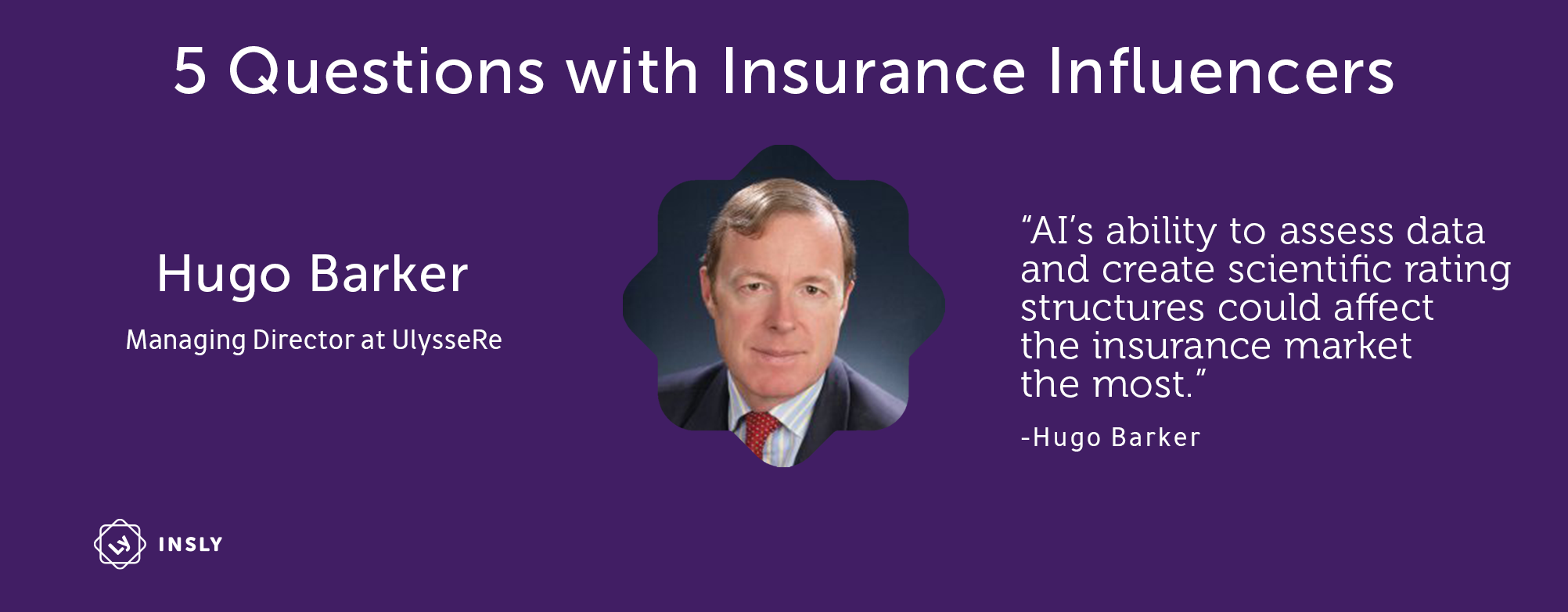We had a chat with Hugo Barker, Managing Director at UlysseRe Reinsurance Brokers.
As the main industry trends for 2022, Hugo points out pricing of traditional vs non-standard insurance products, inflation, and compliance. Speaking of technology, he believes that the ability of AI to assess data and create more scientific rating structures remains the biggest impact that could affect the insurance market.
Have a read and find out what Hugo thought about the rest of our questions.
What are the top 3 trends in the insurance industry for the upcoming year?
Looking ahead to 2022, I see the following three trends.
- Pricing is very varied and splits between traditional standard and non-standard insurance lines.
- Traditional insurance, especially motor and property, did very well during covid in 2020-2021. This allowed Insurers to bolster reserves and create fighting funds. We now see local Insurers becoming more confident and wanting to increase market share again, leading to increased competition in 2022 and lower rates. Meanwhile, Reinsurers have not increased or toughened conditions for these classes over the last two years, which allows Insurers to carry on as before.
- Non-standard insurance, namely marine, aviation, D&O, professional indemnity, and other speciality lines. The market remains hard, because Reinsurers are still seeking to recover the losses they made on these classes in 2017-2020. This has led to them withdrawing proportional reinsurance support in many cases. This, in turn, has led to increased rates and tougher conditions for Insurers, so Insurers themselves react by applying those terms on their original clients. Though some markets have flattened a bit, these classes remain hard and we expect this to continue throughout 2022.
- Inflation – after many years of single-digit inflation, the rates look set to keep rising in 2022 as a result of post-covid effects and the Ukraine invasion. This affects Insurers in things like the increased cost of motor spare parts and construction materials. Insurers have not had the experience of inflation for several years, and will need to vector it into their pricing models going forward.
- Compliance looks set to keep on growing, putting an increased burden on the basic insurance business models. The costs of maintaining higher levels of compliance (KYC, client monitoring, etc.) now include ever more sanctions monitoring as a result of the Ukraine invasion. This means that compliance as a cost keeps growing for Insurers and Brokers, who have to pass it on to the consumer (who is unaware he is paying for it).
More importantly, it eats away at originality and makes Insurers and Brokers less able to create new business models or new business as such. The argument is not recognised by regulators, and it’s hard to see them introducing a new strategy to reduce compliance hurdles. Once they employ new people for a new task, they never seem to downsize them. In fact, regulators seem to instead keep looking for new compliance issues to monitor and apply rules to, to keep these employees busy. The market will have to keep on adapting to it.
What are the main challenges the insurance industry will face during the year?
First and foremost, Insurers will need to deal with the 2022 trends highlighted above. Especially for Central and Eastern Europe, the Russian invasion of Ukraine will complicate business. It will be unknown for a while as to how it will settle.
The main challenge for the industry as ever will be balancing the need to build business against profitability. There have been no major catastrophes since the 2017-2018 hurricanes and 2020 covid, and although worldwide Insurers are seeing profits again, they have not paid back the losses of 2017-2020. Reducing the profit margin too quickly means they might not.
What is the biggest impact technology will have on the insurance industry?
The ability of artificial intelligence to assess data and create more scientific rating structures remains the biggest technology that could affect the insurance market, especially motor insurance. However, it has not happened in most countries and even when it is successful, there are limitations. If the gross profit margin on motor business is 5%, then AI can only increase that by a few points. If it’s too selective as to the risks it writes, it simply loses market share and becomes more profitable on smaller books.
In addition, Insurers are good copycats. If one Insurer using AI creates an appetite for one type of customer or vehicle and is successful doing so, others simply copy and offer competitive rates for the same clients. The bigger the country, the more effective AI can be for motor insurance, but in smaller countries with less sophisticated acquisition models, it will have much less effect in the short term.
Which business models will create the best revenue streams for insurers and MGAs?
Insurers and MGAs need to balance size and profitability, but Insurers can afford to sacrifice profitability for greater size – they have always done so, and always will. On the other hand, MGAs have no margin to do so. They must show profit or they lose capacity.
For MGAs, the best business is the business that has a higher profit margin, and that involves complex underwriting. Insurers will always struggle to underwrite complex business that either involves complicated claims management (e.g. marine liability) or specialised underwriting (e.g. surety). They may have periods of success doing such business in-house, but history tells us they always run into problems at some point. So, MGAs should focus on the classes with higher profitability and complexity.
At the moment, the problem for MGAs is that capacity providers are in a hard market where they can be more selective and focus on larger MGA books. Whereas the smaller and usually more profitable MGAs have been struggling to obtain that capacity over the last 3 years.
What will be the main innovation in terms of product offerings?
The main domain that the insurance market is still trying to create a product for is cyber risk, both commercial and private. The process has been disrupted in two ways.
- Commercial – the plethora of claims from ransomware (claims where the insured is held to ransomware by a virus or malware incident) in 2019-2021 has changed the pricing for commercial cyber insurance. In effect, the market has had to reprice the policy if it includes ransomware exposure or try to offer cyber insurance that does not give ransomware cover.
The problem is that ransomware is so central to cyber insurance that for a company it’s a key part of the cover. The cover has much less value if it is not included. At the moment, the market is in flux with some buyers not being able to get the cover at all, and others not being able to find the cover they want.
- Private – the insurance market is trying to design a cyber insurance cover for individuals. There are a limited number of covers available, but they do not really provide much genuine cover. Individuals are not very keen to buy it, unless it is packaged with another type of insurance.
My optimistic side tells me the market will find a solution both in terms of price and cover for commercial cyber, and increasingly a solution for individuals that provides some form of cover. At this moment, it’s still a minority product, but it has to keep changing and become more commonplace.
About
Hugo Barker has been a Lloyd’s reinsurance broker for 35 years and focused much of his time on the CEE region. He jointly formed MAI CEE Insurance Brokers in the 1990s and was part of the management team that built it into a €10M brokerage with offices across 15 CEE countries.
Since 2015, Hugo has owned and managed UlysseRe, which is a worldwide Lloyd’s wholesale broker unusual for being headquartered in the European Union region in Riga, Latvia. It currently places reissuances for Insurers from 65 countries, giving it a wide worldwide spread. UlysseRe is actively placing capacity for MGAs based in the EU, having placed 13 EU Coverholder capacities in 2021.
Stay tuned for more insurance influencer stories! Don’t forget to check out interviews with Andreas Nemeth, Marco Del Carlo, and Hedi Mardisoo.



